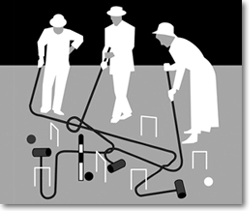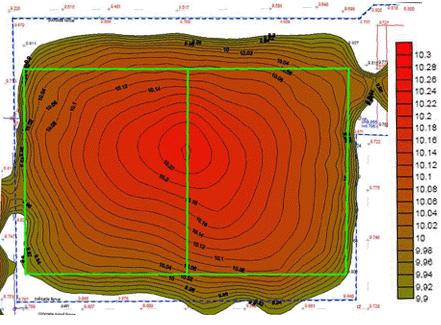
|
Back to |
| The Front Page |
| The Game |
|
At the top of the game: Terrain! |
|
By Bob Alman, with Keith Wylie and others
Posted April 3, 2011
|
The fun of terrain croquet is not seriously questioned - except, perhaps, by true believers in the Holy Church of Croquet. Whether the development of a terrain game should be intentionally encouraged is another question - the crucial question of this article, being revisited once again, in the footsteps of Keith Wylie and others. Whether golf was perfected as a terrain game out of intention or necessity or some combination in its development phases might be impossible to determine. That's what golf is, and someone coming newly to the game might say, "But those slopes and undulations spoil the purity of a game that otherwise might offer a valid and accurate measure of a player's stroke-making skills..." When that argument is successfully made about golf (with non-undulating fairways and perfectly flat greens around the holes) - we'll have an interesting picture of parallel development in another sport.
The legendary Keith Wylie proposed in the English Croquet Gazette of February 1994 a number of changes to the game "that could ease some burgeoning problems." In an article titled "Crown Croquet and Other Reforms," he acknowledges up front that "there is nothing wrong with croquet." At the same time, he observes that "the best players rather like to parade their ability to master difficult lawns, which are there to be mastered, not complained about."

|
| After croquet was created as a back-and-forth contest to the peg, adjustments were made from time to time. The hoops got tighter and firmer. The Willis Setting changed the court. For 150 years, the assumption that the courts should be smooth, fast, and flat has seldom been questioned. Let's question it now and make the game more challenging for all players, more suspenseful for spectators, and easier to manage for greenskeepers and court managers. |
Wylie does not propose that the Croquet Association advocate the building of undulating lawns; what he does suggest is much simpler: having the premier events on "indifferent courts."
With typical wit and style, he says, "There is nothing wrong with the lawns, only with us. It costs so little to change our attitude. Indeed, it would save us money. Let us leave our lawns as they are and adopt the sportsmanlike tolerance of 'the rub of the green' expected of golfers. Love those hills. Cope graciously with those bare patches."
But that was 1994, and this is 2011
In the interval of almost two decades, the lawns around the world have grown relentlessly "better." And who among us would propose taking valued friends to see a top-level tournament on those perfect lawns? Even after the game is "explained," one has to admit that watching the game is hardly more interesting - for a novice - than watching grass grow. No interaction. No suspense. Only excruciatingly long one-player ballets around the court, until the unexplicable retreat and leave at four-back. (Sure, you can "explain it," but it's not worth the effort. Your friends are already comatose.)
But put that game on an undulating lawn, and you'll have a different spectacle, entirely, because your friends will appreciate the difficult of "reading" the lawn and the skill of the players who manage to negotiate hoops on slight hillocks. As Wylie puts it, "No one should underestimate the difficulty of approaching and running a hoop set on the side of slope. There will be shorter breaks, no lifts, and more spectators." It will be a more interesting game, for both players and spectators. You may even have a chance to enlist your friends in learning a game that uses terrain as an ally, instead of an enemy - just as in golf."
Wylie's radical proposal was not adopted by anyone, perhaps because he went on to advocate building smaller, oval "crown courts." In the 21st Century his proposal becomes more practical of application by prizing the terrain courts we already have - especially the ones reclaimed by golf putters and lawn bowlers.

|
| Here's a crown bowling green converted into two half-courts for croquet. Note that the changes in elevation are very slight - yet they produce a spectacular effect which is magnified as the grass is cut shorter. |
Greg Bryant loves Westport terrain
"I've been away playing the West Coast tourney in Westport again... in which I managed to complete the first sextuple! The lawns there are a superb challenge, requiring good 'touch' play due to lawn speeds and careful analysis of the terrain on virtually every shot. Westport lawns are unaffected by automated irrigation and usually run at between 12 - 14 seconds, sometimes quicker after a long dry spell. I refer to them as 'traditional' in that they represent New Zealand croquet lawns as they used to be before the advent of laser leveling and automated irrigation systems.
The playing surface includes Cotulla, bare dirt patches (particularly on boundaries) and....a fine creeping bentgrass (along with a few other weeds). Trenches were originally dug there during WWII and later filled with sand, which I believe contribute to the lawn undulations. Tree roots are also contributing to the rise and fall (and bare patches) of the boundary areas. Westport has hosted a Mac test (1979) and in March 2011 hosted our Premier Silver Badge for players off a minus handicap."
Rich Curtis, former USCA President, says...
"The single court at Biderman Country Club was always my nemesis. Although it's a beautiful setting and the grass is well manicured, it has a huge drop off in the third corner. It was so bad that on one occasion when I played a line ball nine inches away from the corner ball to give it a tight rush, the ball rolled backwards into the corner ball, making a roquet. Extremely pissed, I decided to attack down the line to my opponent's balls near the fourth wicket. Despite giving lots of room for a break towards the line, my ball rolled across the boundary line well before my opponent's balls.
"During CroqCan many years ago at the Toronto Skating Curling and Cricket Club, Rufus Bayard was attempting a medium distance roquet on a ball that was in the court. The shot was on and a short distance before it reached the target ball, it hopped up and over the ball. This would not be that unusual, but fortunately for Rufus it roqueted the object ball on the back side as it was passing over it and actually sent the roqueted ball a few feet back towards Rufus - a reverse rush. "If your idea [for terrain courts] is to take off, it would be absolutely necessary to impose a shot clock. If some players can now spend minutes lining up a reasonably easy peg out, imagine how much time they would actually take to try to 'read' a shot on a green that wasn't true."
For good lawns, Mulliner suggests....
"I advocate NAC3 or something like it (hoop-and-roquet with every third hoop) where, in easy conditions, the players are required to do something different and more difficult. It injects a degree of uncertainty into the completion of a break that is absent at present in easy conditions, which I believe is very similar to the uncertainty that even good players face when playing a conventional break on a challenging lawn."
Kevin Garrad comments from the Isle of Man
"Crown croquet is already played on the Isle of Man! All the bowling greens are crown green, except for just one flat green, to which we [croquet players] are refused access! At one time, on the Isle of Man, we used a public putting green. The whole area was marginally under-size for a full lawn, but we always split it into two short lawns - thus giving the maximum number of players a chance of play. There was a general slope from NE to SW, and many other minor slopes. I did not find it difficult to play a four-ball break (or even a 3-ball break) - I just had to remember to read the lawn, and aim my croquet shots accordingly. The few players who arrived from the England found this concept baffling, and were unable to cope."
Asking and answering tough questions
Players will have a "home court" advantage if they practice on the court, whether or not they're local. The advantage is neutralized if the court is shifted frequently. Croquet lawns the size of bowling greens - 120 x 120 - would be sufficient to allow changing the terrain factors regularly....if not every day, at least for every tournament. The hoop on the hill would be played quite differently if it were moved two feet to the southeast.
Benefits to greens-keepers & court managers
Maintaining lawns needing "reading" will not be as difficult or expensive if swales, rolls, and hills do not need to be leveled and smoothed. Instead of a detriment, they become a positive factor in producing lawns of sufficient difficulty to challenge the best players.
Benefits to spectators
An entirely new element of excitement is added to the game when spectators can comment on how each player approaches specific challenges in the terrain - whether approaching a boundary ball or setting up for a hoop. With the prospect of imminent terrain-generated breakdown, no longer will lift shots and leaves be the only point of interest in top-player games.
Benefits to players
With this substantial "leveling factor," the players will worry less about losing the innings or missing the odd shot, knowing the likelihood is that they'll get more chances to even the score and win the game.
Overall benefits of terrain croquet
Golf Croquet will only benefit from terrain lawns. Association Laws Croquet will become a more interesting, involving, and challenging game at all levels. American Rules Croquet will see more carry-over deadness at the top level.
For the health of the sport and to challenge open-minded and adventurous players: play the game on terrain. Once more, the game that was once labeled "chess on grass" will be sufficiently interactive to merit that description. Back-and-forthness; interesting plays and beautiful shots; and justice at the peg. The goal must always be for the best player in the game to get to the peg first.
Questions, anyone?